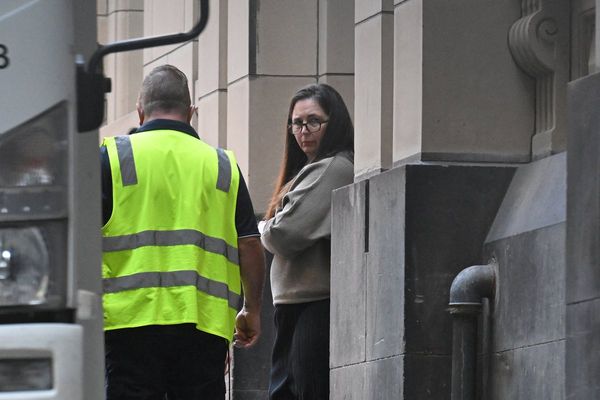
In the first scene of Steven Spielberg’s autobiographical drama The Fabelmans, the director’s junior stand-in Sammy is traumatized by a train crash – not a real one, though the footage from The Greatest Show on Earth that he watches through the wide eyes of a child feels just as vivid and affective. The vision of high-speed destruction haunts little Sammy in his nightmares, until he realizes he can tame the memory by rendering it for the camera. Upon restaging the spectacle with his own model train set and miniature figurines, all the hyperkinetic death turns into a game of make-believe played with innocent toys. With this overture, Spielberg lays out his method for the film to come as he dramatizes the metaphorical trainwreck of his parents’ crumbling marriage to reckon with his place in its breakdown. But he also provides a succinct illustration of the intimate, therapeutic power wielded by horror cinema, its potential to exorcise an artist’s innermost demons by turning to the literally demonic.
The long shadows of Mom and Dad also loom over the terrific and terrifying Longlegs, the latest feature from the closest thing the genre has to royalty, Oz Perkins, son of the Psycho star Anthony. While distributor Neon has shrewdly sold the enigmatic project as a serial killer thriller in line with influences Silence of the Lambs and Se7en, two reasons behind his choice to set the film in the 90s, there’s a far darker, stranger, knottier morass of tormented psychology festering beneath the surface.
In a recent interview with Indiewire, Perkins confessed that he also selected 1993 for its personal significance as one year after Aids claimed the life of his father, one hint at the unloading of family baggage facilitated by fiction. Much like how the unearthly villain going by Longlegs taunts law enforcement with inscrutable hieroglyphic ciphers, Perkins prefers to communicate through encoded symbols that coax formative fears out from a common subconscious. Wes Craven immortally declared that the first monster you have to scare the audience with is yourself; Perkins traps his viewers inside a fevered id, haunted by a boogeyman who returns us to the frightened vantage of a kid seeing something beyond comprehension, that we were never meant to see.
For all the blood spattered across the horror canon, it behooves an auteur to put some of their own skin in the game, even if un-flensed. The term “psychological horror” refers to narratives featuring mental unease at the textual level, but every great tale of terror claws its way deeper into interiority: the shock of self-awareness in Frankenstein’s monster, the perverse carnal charge of Count Orlok, the conflicted duality of Jekyll and Hyde. When a writer excavates their known, real-life skeletons rather than generally rhapsodizing on the prison of humanity, however, the work takes on a special rawness and immediacy. The brooding unknowability of 1981’s Possession, for example, comes into piercing focus with the knowledge that director Andrzej Żuławski channeled his frustrations over his divorce and his emigration from Poland into his howl of unrest in a divided Berlin. Joshua John Miller took a more straightforward tack in this year’s The Exorcism, which imagined his father’s actual experiences acting in The Exorcist and battling alcoholism as the jumping-off point for bona fide unholiness. As the Russell Crowe-played “Anthony Miller” purges himself of malign influence, his inspiration’s son can carry out a less life-or-death version of the same.
Piling on overlapping signifiers and evading clearcut answers, Longlegs lurks in an unsettling middle space, its subtext perceptible yet scrambled. Perkins frames the opening scene with rounded corners and a tightened aspect ratio, as if to evoke a family’s home movie shot in hell: on her birthday, young Lee Harker (Lauren Acala) makes the acquaintance of Longlegs himself (Nicolas Cage), a psychical scar that’s still scabbing over when we rejoin her in adulthood as an FBI field agent (and as Maika Monroe). Lee will eventually discover how her mother (Alicia Witt) protected her that day, but for the time being, the memory rattles around in the back of her mind without revealing its true meaning to her. Freud wrote about the “primal scene”, the universal childhood experience of seeing one’s parents in a sexual situation and reacting with frightened confusion, assuming violence in their thrashing. Lee’s equivalent centers on an act of violence instead, but it reverberates through her life to shape her development in the exact same way.
It’s more of a critical thought experiment than a serious question, but: could Perkins’ primal scene have been his first viewing of Psycho? Norman Bates, the greatest creation of Perkins the Elder, seems like an odds-on reference point in Longlegs’ visual design and Cage’s performance – along with, as the actor has specified, his own mother. The rangy hair, the forced falsetto, and the creepily whimsical body language all point back to the neurotically driven gender-play of Norman moonlighting as Mama Bates, and the startling revelation of the shot exposing Perkins in drag. (Longlegs, as in Daddy, also talks a lot about wigs.) Longlegs’ grim modus operandi specifically hinges on family annihilation, his methods and even mere presence violating the sacred bonds between parent and offspring. He’s not disturbing because he’s got murder on his mind, but because his real goal seems to be killing an entire facet of human nature.
From his earliest maturity, Perkins realized that no one outside of a family can truly, fully understand what goes on within it; this was his takeaway after learning that his father had lived his entire life as a closeted gay man, going so far as to try conversion therapy, all the while supported by his wife, Berry Berenson, up to his death. Her imparted lesson that life often requires us to make complex deals which don’t make sense to other people can be easily slotted into the third-act denouement clarifying how Longlegs does his dirty deeds. But more fascinating still is the stubborn core of the unknowable at the center of this film, represented by a small metal sphere – seamless, opaque, inscrutable. We’re told that it contains the essence of pure evil, perhaps a small part of Satan himself, another absentee father figure in a film constantly prodding and subverting such roles. But the strangeness of that ball, the point at which this procedural makes a definitive break from reality, also forces the viewer back into a naive perspective. To the pre-adolescent, the adult world appears impenetrable, and still they can sense something ominous waiting for them from their fleeting glimpses.
Though playing armchair analyst rarely leads to hard, provable conclusions, free theorizing nonetheless enriches a film as open to interpretation as Longlegs. Half the fun of art comes from the way it brings its authors closer to perfect strangers; watch enough Hitchcock movies, and you start to feel that you know the man, or at least his fetishes and phobias. More than his chillingly unhurried pacing or geometric approach to wide-shot composition, Perkins’ persistent wrestling with the sins of mothers and fathers has given identity to his corpus. The thoroughly underrated Gretel and Hansel challenged one girl to put loyalty to her family over solidarity with her fellow women, where The Blackcoat’s Daughter drove another to madness with the devil’s whisperings about her parents’ deaths. Longlegs moves this preoccupation to the fore without offering any resolution, its only certainty that the lingering specters of those who mess us up never really leave our side.







